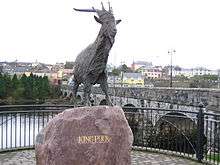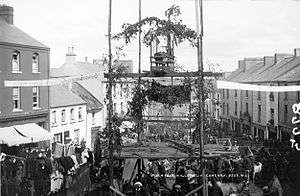Puck Fair
Puck Fair (Irish: Aonach an Phoic, meaning "Fair of the He-Goat", 'poc' being the Irish for a male goat)[1] is one of Ireland's oldest fairs. It takes place annually for three days on the 10th, 11th and 12th of August in Killorglin, County Kerry.

Description

Every year a group of people go up into the mountains and catch a wild goat.[2] The goat is brought back to the town and the "Queen of Puck", traditionally a young school girl from one of the local primary schools, crowns the goat "King Puck".[3]
The goat is then put into a small cage on a high stand for three days, and on the 3rd day of the fair, he is brought down to be led back to the mountains. In the middle of the town square, he is crowned and this signifies that the festivities may begin. The pubs stay open until 3.00 AM which is a legal exception due to the fair as all bars in Ireland normally must close at 2.00 AM. This is a source of contention with the local police.[4]
Markets
Tradition dictates that a horse fair takes place on the first day and on the second day there is a cattle fair. There are usually many street vendors during the festival who advertise their wares to the large numbers of tourists who come to Killorglin for the fair.[5]
History
The fair itself is purported to be ancient but can only officially be traced back as far as 1613 when King James I issued a charter granting legal status to the existing fair in Killorglin. Despite this fact, its roots are still unknown, although there are several legends of its origins.
One of the legends of the fair is that the event pays tribute to a goat that broke away from its herd, while the rest of the herd headed towards the mountains, and warned the town's inhabitants while the “Roundheads” were pillaging the countryside around Shanara and Kilgobnet at the foot of the McGillycuddy Reeks. The advancing army of Oliver Cromwell during his conquest of Ireland in the 17th century triggered the pillages around the countryside. The goat's arrival alerted the inhabitants of danger, and they immediately set out to protect the town and their herds. This is explained in the traditional Irish ballad, An Poc ar Buile (the Mad Puck Goat).
Scholars speculate that the fair's origins stem from Pre-Christian Ireland, from the Celtic festival of Lughnasa which symbolised the beginning of the harvest season, and that the goat is a pagan fertility symbol.[6]
In 1931, Margaret Murray tied the Puck Fair into her version of the witch-cult hypothesis, asserting that it was a pre-Christian festival in honour of the Horned God.[7] However, historians Jeffrey B. Russell and Brooks Alexander have asserted that "Today, scholars are agreed that Murray was more than just wrong – she was completely and embarrassingly wrong on nearly all of her basic premises."[8]
See also
Ireland's Only King, Channel Four Television documentary featuring Henry Kelly, produced & directed by Will Scally BFI.
References
Footnotes
- Southwest Ireland, 5th - Catharina Day - Google Books. Books.google.ie. Retrieved 2012-11-21.
- "Sat, Aug 06, 2011 - Give me a crash course in". The Irish Times. 2011-08-08. Retrieved 2012-11-21.
- "Puck Fair: Ireland's Oldest Festival". Irish America. Retrieved 2012-11-21.
- "Fri, Jul 11, 2008 - Judge refuses to curtail 3am pub closing times at Puck Fair". The Irish Times. 2008-07-07. Retrieved 2012-11-21.
- "Puck Fair - Irelands Oldest Fair, every August 10th, 11th and 12th". Puckfair.ie. Archived from the original on 2012-09-19. Retrieved 2012-11-21.
- "Puck Fair - Irelands Oldest Fair, every August 10th, 11th and 12th". Puckfair.ie. Archived from the original on 2012-11-10. Retrieved 2012-11-21.
- Murray 1952, pp. 43–44.
- Russell & Alexander 2007, p. 154.
Sources
- Murray, Margaret A. (1952) [1931]. The God of the Witches. London: Faber and Faber.CS1 maint: ref=harv (link)
- Russell, Jeffrey B.; Alexander, Brooks (2007). A New History of Witchcraft: Sorcerers, Heretics and Pagans. London: Thames and Hudson. ISBN 978-0-500-28634-0.CS1 maint: ref=harv (link)